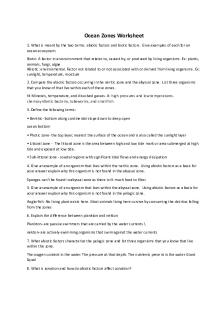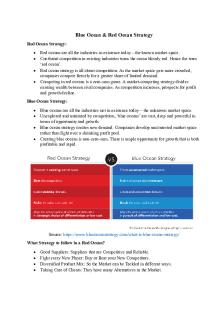Ocean Acidification PDF

| Title | Ocean Acidification |
|---|---|
| Author | Carla Louise |
| Course | Blue Planet |
| Institution | University of Exeter |
| Pages | 2 |
| File Size | 55.4 KB |
| File Type | |
| Total Downloads | 37 |
| Total Views | 141 |
Summary
Ocean acidification....
Description
OCEAN ACIDIFICATION: PROCESSES, IMPACTS, AND SOLUTIONS - Blue Planet As pCO2 in the ocean increases, ocean pH goes down = ocean acidification - Oceanographic records do not go back as far as atmospheric records: global pH database is quite new The carbonate buffer system - 1/3 of atmospheric CO2 natural carbon sinks - CO2 dissolves in water carbonic acid, relatively unstable, will dissociate into bicarbonate (HCO3-) and H+ ions - pH measures H+ concentration, alkalinity measures other ions in sea water - DIC = Dissolved inorganic carbon (CO2, carbonic acid, bicarbonate, carbonate) - pH in ocean atm is = to ~pH 8 Ocean acidification is observable in the ocean - pH observed to be declining by ~0.017 to 0.027 pH per decade - 0.287-0.29pH decline under RCP8.5 by 2100 Why is seawater [CO32-] so important? - Ability for organisms to form CaCO3 shells is directly correlated to the amount of carbonate within the water - Ω > 1 = super saturated - Ω < 1 = under saturated - Arctic has less buffering capacity so change is happening fastest - CO2 dissolved fastest - Polar oceans are becoming more corrosive to calcifying species more quickly Coccolithophores - Almost half of CaCO3 production for our oceans - Important role in the sequestration of carbon into deeper ocean via formation of marine snow - - if already showing evolution?? - Species richness and abundance decreases as the organisms get closer to the CO2 vents where pH goes down Upwelling as a proxy for OA - Deep oceans tend to be cold, oxygen rich, and have high CO2 concentrations - Wind shear pulls up cold water high in CO2 along the coast - Example = north west pacific oyster fishery July 2007 mass die off; corrosive water from upwelling - Availability of carbonate and bicarbonate ions causing mass die off - Chronic effects are shown when saturation hits 2 (1=under saturation) Pteropods - Most sensitive species: aragonite shell - Arctic ocean evident of under saturation through Pteropod research
OA is already showing reef calcification rates Acid base homeostasis - Most smaller marine invertebrates are in equilibrium with their external environment o If pCO2 conc goes up in the water the CO2 in their body will also go up - Not all marine invertebrates can pump out the CO2 metabolic suppression - Any process that is enzyme driven will be affected by changes in pH Ocean acidification ‘solutions’ - MPAs o Removing local stressors will allow for more resilience in the ecosystem - Ocean alkalinity enhancement o Adding buffering capacity to the ocean o Increases carbon sequestration - Super corals: assisted evolution o Stress conditioning, assisted gene flow, modification of microbes, symbiodinium evolution / inoculation - Habitat restoration: blue carbon o Corals near seagrass or mangroves are impacted much less than when they are further away; sequestration of CO2 from the sea water - Reduce carbon footprints o Reducing CO2 emissions...
Similar Free PDFs

Ocean Acidification
- 2 Pages

GEOG 205 Ocean Acidification
- 8 Pages

Acidification lab report
- 10 Pages

Ocean Thermal Energy Conversion
- 5 Pages

Red ocean traps
- 1 Pages

Indian Ocean in Antiquity
- 159 Pages

Nike Blue Ocean Opportunity
- 4 Pages

Blue Ocean Strategy Example
- 1 Pages

10- Blue Ocean Strategy
- 10 Pages

Ocean Zones Worksheet
- 2 Pages

Ocean zones lab report
- 3 Pages

Ocean Carriers Case Study
- 7 Pages

Blue Ocean Strategy
- 1 Pages

Ocean Structure - notes
- 5 Pages
Popular Institutions
- Tinajero National High School - Annex
- Politeknik Caltex Riau
- Yokohama City University
- SGT University
- University of Al-Qadisiyah
- Divine Word College of Vigan
- Techniek College Rotterdam
- Universidade de Santiago
- Universiti Teknologi MARA Cawangan Johor Kampus Pasir Gudang
- Poltekkes Kemenkes Yogyakarta
- Baguio City National High School
- Colegio san marcos
- preparatoria uno
- Centro de Bachillerato Tecnológico Industrial y de Servicios No. 107
- Dalian Maritime University
- Quang Trung Secondary School
- Colegio Tecnológico en Informática
- Corporación Regional de Educación Superior
- Grupo CEDVA
- Dar Al Uloom University
- Centro de Estudios Preuniversitarios de la Universidad Nacional de Ingeniería
- 上智大学
- Aakash International School, Nuna Majara
- San Felipe Neri Catholic School
- Kang Chiao International School - New Taipei City
- Misamis Occidental National High School
- Institución Educativa Escuela Normal Juan Ladrilleros
- Kolehiyo ng Pantukan
- Batanes State College
- Instituto Continental
- Sekolah Menengah Kejuruan Kesehatan Kaltara (Tarakan)
- Colegio de La Inmaculada Concepcion - Cebu

